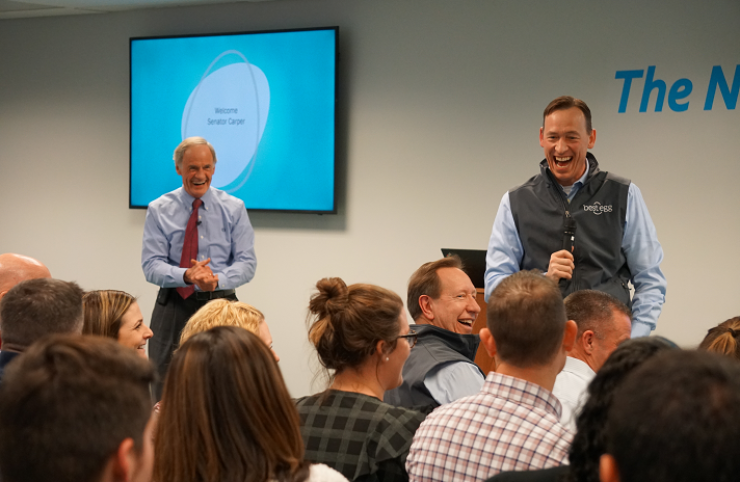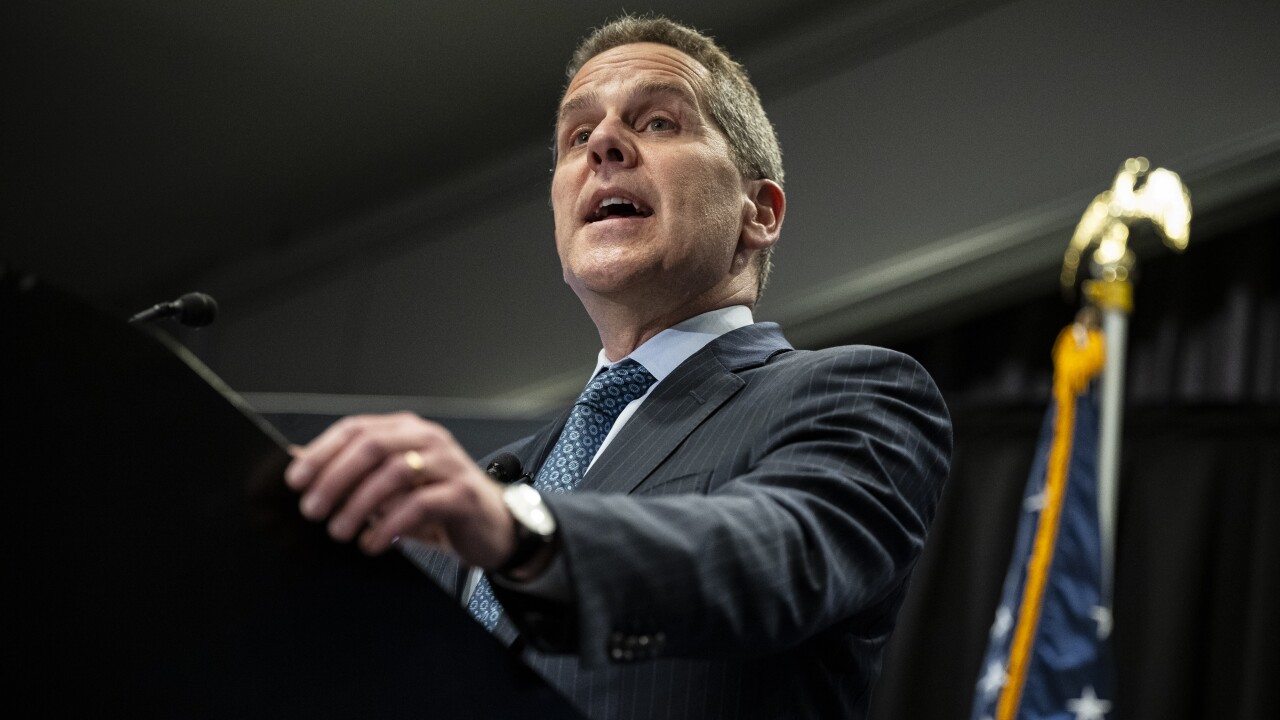Not long after Chris Anderson came to work in San Diego as a middle manager at Mortgage Capital Trading, he had an idea about how to make the company more efficient.
“I saw my guys doing a ton of manual data entry, and I thought, there must be an easier way,” he recalled.
Anderson, who is now the chief administrative officer at the housing finance company, gathered some of his employees and brainstormed a tech solution to their problem.They ended up creating a program that automated a large part of the team’s workflow.
Mortgage Capital’s management immediately realized the value of the change and endorsed its adoption. Not incidentally, the company began charging customers a premium for its new, expedited services.
A common characteristic of many of the companies named in this year’s

The companies can reap substantial benefit from doing so, and in the case of Mortgage Capital, that benefit is shared with employees.
Though some companies might have made sure Anderson received praise from executives — or maybe even given him a performance bonus at the end of the year — the model at Mortgage Capital is more generous.
The company calculated how much money it was making as a result of the new system, and funneled a share of it — on an ongoing basis — to Anderson and his team members.
More than five years later, the system is still being used.
A senior trader at the company had a similar experience just recently. Working on his own time, he came up with a tech solution for aggregating and analyzing the large amounts of data the company collects about the mortgage markets, and reaped the benefits.
(
“Our primary clients are lenders and this is a tool we were able to sell to some of the largest correspondent lenders in the country,” Anderson said. “He took the ball, ran with it, and it’s a tool that’s profitable, and he participates heavily in those profits.”
It’s recognizing the contributions of all those who work there — even those who aren’t in a management role — that propels Mortgage Capital to a high score in employee satisfaction, Anderson said.
“Employees like to be on the cutting edge and they like to be part of an organization that will recognize if they have a good idea and know that it could be reaching product viability pretty darn quick,” he added.
Information Flows Freely
To companies on the list of Best Fintechs to Work For, employee input is valuable enough to seek out. They typically foster a lot of interaction between the managers at the very top of the organizational chart and people at all levels below them.
PeerStreet’s co-founders Brew Johnson and Brett Crosby make sure to meet with their entire workforce weekly.
Every Monday, “we bring the whole company together,” said Crosby, who is the chief executive at PeerStreet, a person-to-person lending startup in Manhattan Beach, Calif. “It’s an expensive meeting, because it’s a lot of people’s time. But we think it’s important. We go through our metrics, talk about what happened last week, talk about what’s happening this week.”
In the event there are problems, “People who are responsible for those can go do something about it,” he said. Importantly, “they can also get ideas from other people in the company. It keeps people much more engaged and they feel like they are part of everything that’s going on.”
Again and again, fintechs with high employee engagement and satisfaction describe an atmosphere in which information flows freely across organizational lines — and flows in both directions.

At Promontory Interfinancial Network in Arlington, Va., marketing director Amy Manship describes an “amazingly flat” corporate structure, where employees get the same information about the company’s performance that board members receive, and where senior management is eager to interact with more junior employees. “All of us are on an equal plane,” she said. “We’re all kept in the loop.”
There’s a similar sense of direction at Best Egg, a lender in Wilmington, Del., said Sabrina Basht, its chief strategy officer. “We have a clear mission, clear goals you want to achieve, and clear time frames. We empower people to come up with ideas and ways to get us to those goals, and it’s a recipe for a really energized organization.”
This type of open communication creates a culture of accessibility, said Misty Vojvoda, director of human resources at the payments system provider Ensenta, which was acquired in December by Jack Henry & Associates.
The goal is an environment “where all employees feel comfortable approaching their manager or supervisor with ideas or innovative things — anything that they may want to talk to somebody about and be heard,” she said. “Managing up is very encouraged here and that empowers employees to feel like they are an important part of the team as a whole.”
Giving Employees Influence
Steven Smith, the chief executive of Finicity, a personal finance information provider in Murray, Utah, seeks out the opinions of his workforce on a more frequent basis. Once a month he has a catered lunch with every employee whose birthday falls in that month.
"I say, ‘Today you can ask any question you want and I’ll do my best to answer it,' " Smith said. "It’s a conversation with no framework or objective."
Sometimes he adds agenda items to executive meetings based on input he receives. He also gains an understanding of how well different groups are working together and what the morale level is at the company.
"It’s a great way for me to have my finger on the pulse."
Executives at the Best Fintechs to Work For said they tend to let employees influence both outward-facing business decisions and their day-to-day work environment.
Computer Services Inc. in Paducah, Ky., has employees fill out an engagement survey once a year and management scans the comment section closely.
“Every year we always implement at least a couple of changes that are directly requested from the comments,” said Beth Riddle, vice president of human resources.
In recent years, employee comments have led to an overhaul of both the company’s family leave policy (new moms now get 12 weeks of full-pay maternity leave; dads get two weeks) and its vacation policy (new hires now start with three weeks rather than two, as they had under the old policy).
'Pride of Ownership'
At the digital banking company Kasasa, in Austin, Texas, a group of nonmanagerial employees known as the Patch Committee makes critical decisions about things as seemingly minor as what soda brands are stocked in the breakroom and as major as creating a governance process for the company’s “Love Fund” — an employee assistance program that has handed out hundreds of thousands of dollars in aid to those in distress.
Named for the “patch” logo that symbolizes the company’s values, the Patch Committee operates with minimal oversight from upper management, and is responsible for fielding all employee requests and responding to them in a timely manner, said CEO Gabe Krajicek.

“Any employee can email the Patch Committee at any time and we have to give them a 'Yes-plus-when' or a 'No-plus-why' answer in a very timely way,” Krajicek said.
A request ticketing system tracks employee queries and ensures that “every employee gets that clear closure on any recommendation they make,” the CEO said.
Cross River Bank in Fort Lee, N.J., relies on employees to help guide its charitable giving, said Marc Miller, its chief people officer.
“Any employee can present any charitable organization for us to donate to and we will donate generously to each one,” he said. The company also recently created a matching fund meant to amplify employees’ personal donations to causes of their own choosing.
Whether the employees are seeing their influence take effect internally or externally, the impact is similar.
According to Miller, when Cross River employees see the bank making a difference in the community — a difference guided by the employees themselves — it has a positive effect on their attitude.
“They feel they’re not just working for a company in the business of making money,” he said. “They’re proud to be a part of the company.”
At Mortgage Capital, Anderson said the company fast-tracks employee proposals to improve operations.
“When ideas get adopted very quickly, and they are able to see that adoption, and they are able to interact with their clients and say, ‘That was my idea.’ They can take some pride of ownership.”





